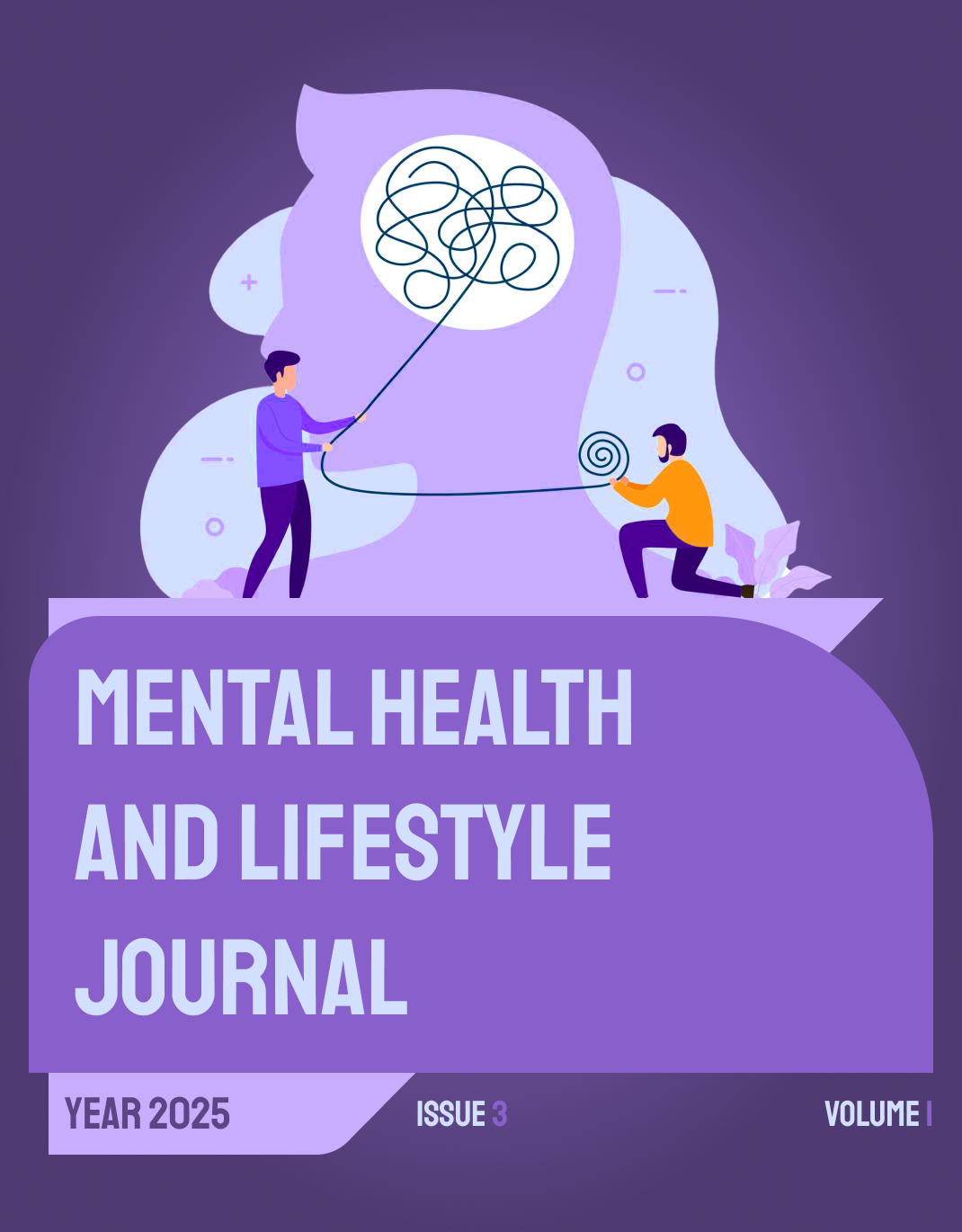The Relationship Between Childhood Traumatic Experiences and Rumination with Suicidal Thoughts
Keywords:
Childhood trauma, rumination, suicidal ideation, cognitive vulnerabilityAbstract
This study aimed to investigate the relationship between childhood traumatic experiences and rumination with suicidal thoughts among university students. The present research employed a descriptive-correlational and explanatory design using structural equation modeling (SEM) within a cross-sectional framework. The statistical population included all students at Islamic Azad University of Lahijan (N = 9031), from which 210 participants were selected through purposive convenience sampling. Data were collected using the Childhood Trauma Questionnaire (CTQ), the Beck Scale for Suicidal Ideation, and the Ruminative Responses Scale by Nolen-Hoeksema and Morrow (1991). Descriptive statistics, Pearson correlation coefficients, and multiple regression analyses were used to analyze the data. The results indicated that both childhood traumatic experiences and rumination were significantly correlated with suicidal thoughts. Pearson’s correlation coefficients revealed strong positive relationships between childhood trauma and suicidal ideation (r = 0.90, p < .001), and between rumination and suicidal ideation (r = 0.95, p < .001). Regression analysis further confirmed the predictive role of these variables, with childhood trauma (B = 0.54, p < .001) and rumination (B = 0.22, p < .001) both emerging as significant predictors of suicidal thoughts. These results highlight the direct and independent contributions of both trauma and ruminative thinking to the development of suicidal ideation. The findings suggest that students with a history of childhood trauma and a tendency toward ruminative thinking are at a significantly higher risk for suicidal ideation. Addressing these factors through early screening, trauma-informed interventions, and cognitive-behavioral strategies targeting rumination may be critical for effective suicide prevention among university populations.
Downloads
References
1. Mills AL, Aquino GA, Hoegler S, Cummings EM. Interparental Conflict, Emotional Insecurity, and Parent–Adolescent Communication. Journal of Family Issues. 2020;42(10):2377-96. doi: 10.1177/0192513x20980035.
2. Ching BH, Wu X. Parental Conflicts and Materialism in Adolescents: Emotional Insecurity as a Mediator. Journal of Adolescence. 2018;69(1):189-202. doi: 10.1016/j.adolescence.2018.07.019.
3. Colton KC, Godleski SA. Socialization of Adolescent Emotion Regulation Through Interparental Conflict: Adolescent Versus Parent Report. Family Relations. 2024;74(1):163-79. doi: 10.1111/fare.13121.
4. López‐Larrosa S, Sánchez-Souto V, Ha AP, Cummings EM. Emotional Security and Interparental Conflict: Responses of Adolescents From Different Living Arrangements. Journal of Child and Family Studies. 2019;28(5):1169-81. doi: 10.1007/s10826-019-01364-1.
5. Bergman KN, Choe GE, Cummings EM, Davies PT. The Ubiquitous Family Environment: Examining Emotional Insecurity in the Family and Adjustment in School. Family Court Review. 2018;56(2):234-47. doi: 10.1111/fcre.12337.
6. Dragomir AM. The Importance of Coparental Behaviors in the Development of Children’s Emotional Security. Psihologia Revista Științifico-Practică = Psychology Scientific-Practical Journal. 2024;45(2):16-23. doi: 10.46728/pspj.2024.v45.i2.p16-23.
7. Kosutić Z, Mitković-Vončina M, Dukanac V, Lazarević M, Raković-Dobroslavić I, Soljaga M, et al. Attachment and Emotional Regulation in Adolescents With Depression. Vojnosanitetski Pregled. 2019;76(2):129-35. doi: 10.2298/vsp160928060k.
8. Veena KP, Noufal P. Emotional Integration and Social Security of Adolescents at Higher Secondary Level. Shanlax International Journal of Education. 2020;9(1):86-91. doi: 10.34293/education.v9i1.3490.
9. Jiménez-Rodríguez T, Barrera Udl, Schoeps K, Valero‐Moreno S, Montoya‐Castilla I. Longitudinal Analysis of Adolescent Adjustment: The Role of Attachment and Emotional Competence. Children. 2022;9(11):1711. doi: 10.3390/children9111711.
10. Jacoby VM, Krackow E, Scotti JR. Betrayal Trauma in Youth and Negative Communication During a Stressful Task. The International Journal of Aging and Human Development. 2016;84(3):247-75. doi: 10.1177/0091415016669724.
11. Yang R, Gu Y, Cui L, Li X, Way N, Yoshikawa H, et al. A Cognitive Script Perspective on How Early Caregiving Experiences Inform Adolescent Peer Relationships and Loneliness: A 14‐year Longitudinal Study of Chinese Families. Developmental Science. 2024;27(6). doi: 10.1111/desc.13522.
12. Andretta JR, McKay MT, Harvey S, Perry JL. Inventory of Parent and Peer Attachment–Revised Scores in Adolescents: A Psychometric and Person‐Oriented Study. Family Relations. 2017;66(3):527-40. doi: 10.1111/fare.12252.
13. Yanti RAP, Mariyati LI. Relationship of Secure Attachment to Fathers and Mothers With Emotional Intelligence in Junior High School Adolescents. Indonesian Journal of Innovation Studies. 2023;21. doi: 10.21070/ijins.v21i.800.
14. Venta A, Sharp C, Shmueli‐Goetz Y, Newlin E. An Evaluation of the Construct of Earned Security in Adolescents: Evidence From an Inpatient Sample. Bulletin of the Menninger Clinic. 2015;79(1):41-69. doi: 10.1521/bumc.2015.79.1.41.
15. Carapeto M, Domingos R, Veiga G. Attachment and Depressive Symptoms in Adolescence: The Mediatory Role of Emotion Awareness. Behavioral Sciences. 2022;12(10):405. doi: 10.3390/bs12100405.
16. Smith RM, Dys SP, Moretti MM. Fathers’ Emotion Regulation, Mindful Parenting, and Adolescent Attachment Quality. 2023. doi: 10.31234/osf.io/myc3k.
17. Muslima A. Phobia Impacts on Adolescents' Psychological Security: A Psychoanalytic Approach. Academia Open. 2023;8(1). doi: 10.21070/acopen.8.2023.6579.
18. Faryal Youssef Al-Khatib Mohammad Ali A. The Relationship of Self Assertiveness in Psychological Security and Emotional Intelligence Among a Sample of Middle Adolescence Students in North Jordan: علاقة توكيد الذات بالأمن النفسي والذكاء الانفعالي لدى عينة من طلبة مرحلة المراهقة المتوسطة في شمال الأردن. مجلة العلوم التربوية و النفسية. 2021;5(30):119-46. doi: 10.26389/ajsrp.m030221.
19. Asgola S, Kaur S. Psycho-Social Problems Among the Adolescent Girls Experiencing Sexual Harassment in Punjab. Asian Journal of Home Science. 2018;13(1):1-10. doi: 10.15740/has/ajhs/13.1/1-10.
20. Zimmermann P, Spangler G. Effects of Gene × Attachment Interaction on Adolescents’ Emotion Regulation and Aggressive Hostile Behavior Towards Their Mothers During a Computer Game. Frontiers in Human Neuroscience. 2016;10. doi: 10.3389/fnhum.2016.00254.
21. Xie D, Lu J, Xie Z. Online Emotion Regulation Questionnaire for Adolescents: Development and Preliminary Validation. Social Behavior and Personality an International Journal. 2015;43(6):955-65. doi: 10.2224/sbp.2015.43.6.955.
Downloads
Published
Submitted
Revised
Accepted
Issue
Section
License

This work is licensed under a Creative Commons Attribution-NonCommercial 4.0 International License.










